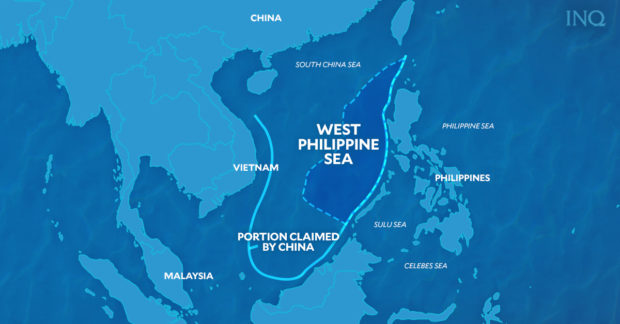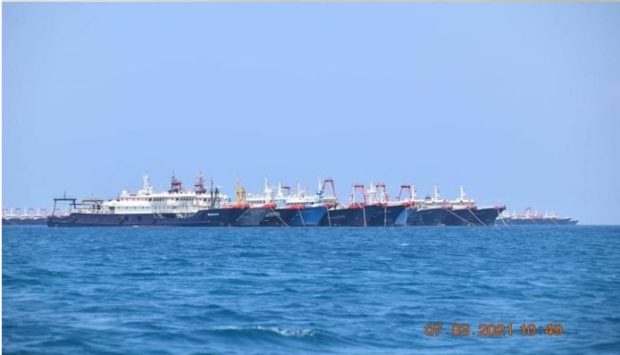Agence France-Presse / 07:16 AM January 13, 2022

On July 12, 2016, the United Nations-backed Permanent Court of Arbitration in The Hague ruled in favor of the Philippines, invalidating China’s claim of historic rights to resources within the South China Sea within its “nine-dash line.” (INQUIRER FILES)
WASHINGTON – The United States on Wednesday laid out its most detailed case yet against Beijing’s “unlawful” claims in the South China Sea, rejecting both the geographic and historic bases for its vast, divisive map.
In a 47-page research paper, the State Department’s Bureau of Oceans and International Environmental and Scientific Affairs said China had no basis under international law for claims that have put Beijing on a collision course with the Philippines, Vietnam and other Southeast Asian nations.
“The overall effect of these maritime claims is that the PRC unlawfully claims sovereignty or some form of exclusive jurisdiction over most of the South China Sea,” the paper said, referring to the People’s Republic of China.
“These claims gravely undermine the rule of law in the oceans and numerous universally recognized provisions of international law reflected in the Convention,” it said, referring to a 1982 UN treaty on the law of the sea ratified by China — but not the United States.
Releasing the study, a State Department statement called again on Beijing “to cease its unlawful and coercive activities in the South China Sea.”


Around 220 Chinese militia vessels were spotted moored at Julian Felipe Reef in the West Philippine Sea last March 7, 2021. (NTF WPS)
The paper is an update of a 2014 study that similarly disputed the so-called “nine-dash line” that forms the basis for much of Beijing’s stance.
In 2016, an international court sided with the Philippines in its complaints over China’s claims. Beijing replied by offering new justifications, including saying that China had “historic rights” over the area.
The State Department paper said that such historical-based claims had “no legal basis” and that China had not offered specifics.
It also took issue with geographic justifications for China’s claims, saying that more than 100 features Beijing highlights in the South China Sea are submerged by water during high tide and therefore are “beyond the lawful limits of any state’s territorial sea.”
Beijing cites such geographic features to claim four “island groups,” which the State Department study said did not meet criteria for baselines under the UN convention.
The report was issued as the United States increasingly challenges China on the global stage, identifying the rising communist power as its chief long-term threat.
In 2020, then-secretary of state Mike Pompeo explicitly backed claims of Southeast Asian nations in the South China Sea, going beyond the past US stance of challenging China without taking an issue on which countries were right.
The South China Sea is home to valuable oil and gas deposits and shipping lanes, and Beijing’s neighbors have frequently voiced concern that their giant neighbor was seeking to expand its reach.
New US report dismisses Beijing's claim to South China Sea 'historical rights'
JANUARY 12, 2022

Chinese coastguard ships in the South China Sea on July 15, 2014.
Reuters file
The US government stepped up its criticism of China's territorial claims in the South China Sea on Wednesday (Jan 12), issuing a report that declares "historical rights" a meaningless term.
Referencing the 1982 United Nations Convention on the Law of the Sea (Unclos) and an international ruling dismissing most of China's claims in the South China Sea, the US State Department said in its report, titled Limits in the Seas, that they "gravely undermine the rule of law in the oceans".
The report comes amid ongoing tensions between China and rival claimants in the South and East China Seas, and follows recent reports in the Japanese media that Japanese warships have conducted freedom of navigation patrols near the disputed Spratly Islands in a bid to deter Beijing.
Beijing asserts "historic rights" over more than 80 per cent of the South China Sea region, including the Spratlys, via its "nine-dash line"— an area stretching as far as 2,000km from the mainland and reaching waters close to Indonesia and Malaysia.
The July 2016 ruling by an international tribunal in The Hague determined that China had no "historic rights" in the South China Sea and ruled that some of the rocky outcrops claimed by several countries could not legally be used as the basis for territorial claims.
Chinese foreign ministry spokesman Zhao Lijian said last year, amid a dispute with the Philippines over a massing of hundreds of Chinese ships near the Spratly Islands, that the ruling was "an invalid waste of paper".
Indonesia asserts authority near South China Sea amid Chinese intrusions

"No provision of the Convention contains the term 'historic rights', nor is there a uniform understanding of what, specifically, the term means as a matter of international law," the State Department's report said.
"Any claim to such rights would need to conform to the Convention's provisions, including with respect to the areas of [exclusive economic zone], continental shelf and high seas," it said.
The report also disputed China's claims to more than 100 features in the South China Sea that are submerged during high tide — precluding them from sovereignty claims under international law.
It stressed that any feature's legal status must be assessed based on its "natural state", an apparent reference to China's creation over the past decade of thousands of acres of new land in the Spratly Islands through dredging and artificial island building.
"Land reclamation or other human activities that alter the natural state of a low-tide elevation or fully submerged feature cannot transform the feature into an island," the report said.
Alongside Wednesday's report, the 150th in a 52-year series examining the validity of maritime claims around the world, the State Department also released Chinese and Vietnamese translations of its executive summary.
The document builds on previous warnings about China's territorial claims in the South China Sea by US President Joe Biden's administration and that of his predecessor, Donald Trump.
In July, the Biden administration endorsed a determination by the Trump administration that virtually all of China's maritime claims in the South China Sea were unlawful, and vowed to act militarily if China were to attack any Filipino vessel or aircraft in the region.
Disputes between Beijing and Washington over the South China Sea have been escalating since Beijing began land reclamation operations in 2016 in some of the features it controls in the ocean's Spratly archipelago.
The Biden administration contends that Beijing's actions in the South China Sea threaten some US$3 trillion (S$4 trillion) worth of commerce that passes through the region each year.
During a tour of Southeast Asian nations last month, US Secretary of State Antony Blinken vowed that the US, along with other countries who claim territories in the South China Sea, would "continue to push back on such behaviour".
China's embassy in Washington did not immediately respond to a request for comment about the State Department report, which is likely to anger the Chinese government.
"It is not China that has long been stirring up trouble in the South China Sea and posing a grave threat and major risks to regional peace and stability under the pretext of 'freedom of navigation'," Zhao said in December following Blinken's remarks. "I'm sure we all know which country is in the habit of doing all these. I hope US officials will not misrepresent facts."
READ ALSO: Philippines says China is ‘the trespasser’ as it refuses to move ship from disputed South China Sea shoal
This article was first published in South China Morning Post.









 The Texas Department of Family and Protective Services has faced criticism for housing foster youth in hotels or social workers’ offices when unable to find them safe housing. During a hearing Tuesday, a panel of independent child welfare experts made recommendations to the state that included lessening its reliance on congregate care.
The Texas Department of Family and Protective Services has faced criticism for housing foster youth in hotels or social workers’ offices when unable to find them safe housing. During a hearing Tuesday, a panel of independent child welfare experts made recommendations to the state that included lessening its reliance on congregate care.
